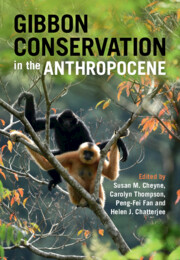Book contents
- Gibbon Conservation in the Anthropocene
- Gibbon Conservation in the Anthropocene
- Copyright page
- Contents
- Contributors
- Foreword
- Abbreviations
- Introduction
- 1 Taxonomy, Ecology and Conservation of Cao Vit Gibbon (Nomascus nasutus) since Its Rediscovery
- 2 Conservation Status of the Northern Yellow-Cheeked Crested Gibbon (Nomascus annamensis) in Vietnam
- 3 Strategies for Recovery of the Hainan Gibbon (Nomascus hainanus)
- 4 Gibbons in the Anthropocene
- 5 Demography of a Stable Gibbon Population in High-Elevation Forest on Java
- 6 A Tale of Two Gibbon Studies in Thailand
- 7 Accessibility as a Factor for Selecting Conservation Actions for Pileated Gibbons (Hylobates pileatus)
- 8 Calling from the Wild
- 9 Demography and Group Dynamics of Western Hoolock Gibbons (Hoolock hoolock) in a Community Conserved Village Population in Upper Assam, India
- 10 Challenges and Prospects in the Conservation of Hoolock Gibbon in India
- 11 Gibbons of Assam
- 12 Movement Ecology of Siamang in a Degraded Dipterocarp Forest
- 13 Sympatric Gibbons in Historically Logged Forest in North Sumatra, Indonesia
- 14 Adopting an Interdisciplinary Biosocial Approach to Determine the Conservation Implications of the Human–Gibbon Interface
- 15 Listen to the People, Hear the Gibbons Sing
- 16 Long-Term Outcomes of Positive Cultural Value for Biodiversity
- 17 Gibbon Phylogenetics and Genomics
- 18 The Use of Microsatellites in the Management of Captive Gibbons
- Index
- References
3 - Strategies for Recovery of the Hainan Gibbon (Nomascus hainanus)
Twenty Years of Multidisciplinary Conservation Effort
Published online by Cambridge University Press: 13 April 2023
- Gibbon Conservation in the Anthropocene
- Gibbon Conservation in the Anthropocene
- Copyright page
- Contents
- Contributors
- Foreword
- Abbreviations
- Introduction
- 1 Taxonomy, Ecology and Conservation of Cao Vit Gibbon (Nomascus nasutus) since Its Rediscovery
- 2 Conservation Status of the Northern Yellow-Cheeked Crested Gibbon (Nomascus annamensis) in Vietnam
- 3 Strategies for Recovery of the Hainan Gibbon (Nomascus hainanus)
- 4 Gibbons in the Anthropocene
- 5 Demography of a Stable Gibbon Population in High-Elevation Forest on Java
- 6 A Tale of Two Gibbon Studies in Thailand
- 7 Accessibility as a Factor for Selecting Conservation Actions for Pileated Gibbons (Hylobates pileatus)
- 8 Calling from the Wild
- 9 Demography and Group Dynamics of Western Hoolock Gibbons (Hoolock hoolock) in a Community Conserved Village Population in Upper Assam, India
- 10 Challenges and Prospects in the Conservation of Hoolock Gibbon in India
- 11 Gibbons of Assam
- 12 Movement Ecology of Siamang in a Degraded Dipterocarp Forest
- 13 Sympatric Gibbons in Historically Logged Forest in North Sumatra, Indonesia
- 14 Adopting an Interdisciplinary Biosocial Approach to Determine the Conservation Implications of the Human–Gibbon Interface
- 15 Listen to the People, Hear the Gibbons Sing
- 16 Long-Term Outcomes of Positive Cultural Value for Biodiversity
- 17 Gibbon Phylogenetics and Genomics
- 18 The Use of Microsatellites in the Management of Captive Gibbons
- Index
- References
Summary
The Hainan gibbon (Nomascus hainanus) is endemic to China’s Hainan Island, and is the world’s rarest primate species. With rampant deforestation and hunting, by 1980 less than 10 individuals reportedly survived at Bawangling National Nature Reserve. A systematic population census in 2003 confirmed only 13 individuals and it was feared that it would be the first modern primate species to go extinct. In 2003, Kadoorie Farm and Botanic Garden was invited by the local conservation authority to take an active role in saving the species from extinction. Together with relevant government agencies and other stakeholders, a conservation strategy with prioritised conservation actions were devised and implemented; these ranged from reforestation of prime lowland habitat, establishment of gibbon monitoring teams, scientific research, awareness-raising and provision of alternative livelihoods to surrounding communities. With years of continuous presence and open dialogue, the local authorities and communities embraced the suite of conservation actions, and the species is on a slow but steady recovery pathway. The population is expanding its range and currently stands at five family groups of at least 34 gibbons.
Keywords
- Type
- Chapter
- Information
- Gibbon Conservation in the Anthropocene , pp. 40 - 56Publisher: Cambridge University PressPrint publication year: 2023



